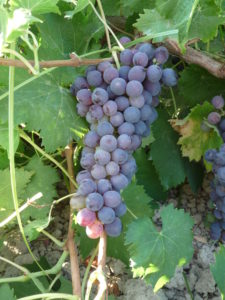Climate Change and Maltese Wine

A grape bunch of late-ripening Ġellewża at the time of veraison.
New research from NASA’s Goddard Institute for Space Studies and Harvard University has found that climate change has caused earlier grape harvests in France and other European countries over the last 30 years. Grapes in France are now being picked two weeks sooner on average than they were in the past. Each degree Celsius of warming brings the grape crush forward roughly by one week.
This is a concern for winemakers since it’s generally accepted that, all other things being equal, shorter ripening periods result in less flavoursome grapes. It’s likely that wines from many northern European regions we know today, as a result of climate change, might end up being less delicate, flabbier and overly alcoholic.
New terroirs are already being tried in anticipation. French Champagne houses, for example, are turning cooler pastures in the UK into vineyards for sparkling wine production. They’ve also restarted using the formerly side-lined Arbane, Fromentot, Blanc Vrai and Petit Meslier varieties which are naturally tarter to counteract warm vintages at home.
In another 50 years or so, more new wine regions might emerge whilst existing famous wine appellations become less suitable.
Will the wine industry in Malta be affected by climate change?
Malta cannot escape global climate variations, but how climate change will affect the vintages of the future is hard to say. At this stage it’s very difficult for climatologists to predict effects on viticulture even with the best of computer simulation models.
However, being passionate about Malta’s wines, I can’t help but speculate and make an educated guess.
Locally, the effects might not be as immediate as in nearby countries. Malta has a small land mass and vineyards are cooled by the surrounding Mediterranean Sea and winds. Besides, most international varieties that recently have been planted are suitable for a warm climate: they’re rather heat resistant and grafted on carefully selected drought resistant rootstocks.
Many believe that climate change will push more wineries in Europe to re-discover their native grapes because probably a variety such as Grillo, native to Sicily and grown by the sea, can resist high temperatures better than the more recently arrived noble varieties in the same region.
In Malta two indigenous grapes varieties, Girgentina and Ġellewża, are luckily still cultivated. They’ve already had centuries of adaptation to our soils. Both uniquely Maltese grapes are naturally unhurried and late ripening, with a heavy leaf canopy providing ample shade to retain acidity, which is a problem when the quicksilver rises.
Some varieties have in their genes a greater potential for adaptation to heat than others. Girgentina and Ġellewża might be the vines we will pay more attention to if the effects of new climate variations become more pronounced.
Meanwhile, like anywhere else, it’s a fact that since grape growers can’t control the thermostat, they’ll have to adjust their viticultural practices and winemakers the style of their wines. The good news is that, as the climate is shifting, our viticultural knowledge in Malta is also deepening, and day by day smarter techniques allow us to adapt our vineyard management to achieve top quality levels.
This article by Georges Meekers appeared first in the Times of Malta, 6th May 2016


